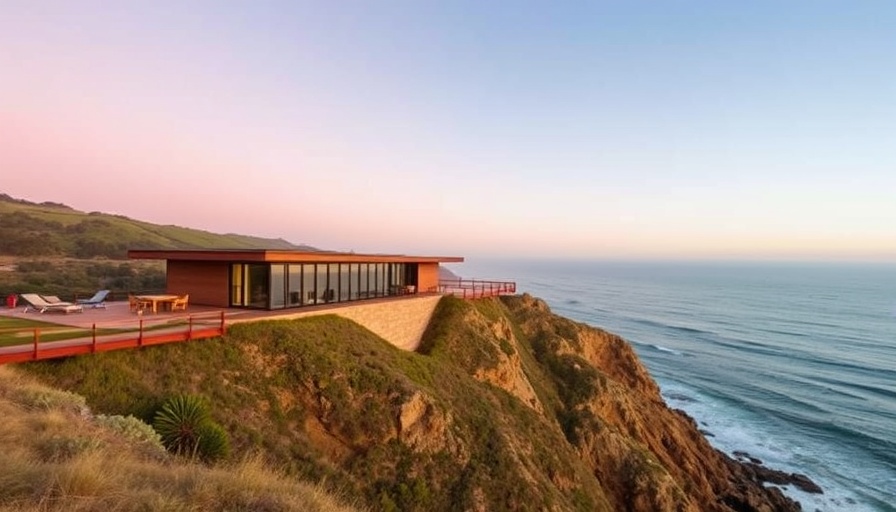
Captivating Coastal Retreat: The Big Sur House
Perched elegantly on a bluff in Big Sur, California, the newly designed Big Sur House by Field Architecture epitomizes a harmonious blend of nature and modern living. This architectural marvel stands as a testament to the beauty of coastal living, inviting its residents to embrace their surroundings while catering to the demands of modern life.
Embracing Nature: The Design Philosophy
The design philosophy of the Big Sur House is deeply rooted in its environment. Field Architecture aims to create spaces that nurture a connection with nature, where every turn reveals a thoughtfully framed view of the landscape. The bulky structure is organized around a central ravine, which plays a significant role in its architectural flow. This ravine not only divides the house into distinct spaces but also enhances the natural beauty of the site, making it an integral part of the home's identity.
Field Architecture notes, "Movement through the house is orchestrated as a series of framed views of the landscape that bring the residents closer to nature with every turn." This intentional movement encourages occupants to experience the tranquility and splendor of the natural world, reminding them to appreciate the moment, especially in a fast-paced digital era where distractions abound.
The Perfect Workspace Inspiration
While the use of expansive glass walls and elegant materials like stone and wood create a serene residence, they also provide valuable insights for digital nomads looking to establish their own productive workspaces. The light-filled areas of Big Sur House offer the perfect reminder that a well-lit environment is crucial for productivity. Natural light is not just aesthetically pleasing; it substantially enhances mood and cognitive function, encouraging creativity and focus.
Creating a workspace mimicking the openness and lightness found at Big Sur can lead to a more productive atmosphere at home or wherever your remote job takes you. For instance, integrating large windows that overlook calming views of nature, or designing workspaces that mimic the tranquility of the garden courtyards in Big Sur, can encourage a peaceful working state conducive to concentration.
Functionality Meets Aesthetics: Materials that Inspire
The choice of materials at Big Sur House—wood, stone, and glass—reinforces the connection between the indoor environment and the natural landscape. For those developing home offices or workspaces, these materials not only add a beautiful aesthetic but also support wellness through better acoustic dampening and temperature control. Incorporating materials like reclaimed wood or natural stone can create a grounding effect, an essential quality for any workspace.
Additionally, the exterior features of the Big Sur House, such as the engawa—a wooden ledge that runs along traditional Japanese buildings—can inspire workspace design as they promote a seamless transition between inside and outside. This can be emulated by having outdoor work areas, patios for breaks, or simply making glass walls a common feature in home offices.
Inspiring Innovation: Adapting the Big Sur House Design
Field Architecture's commitment to innovation is evident in the fluidity of spaces, allowing for multifunctionality. This feature is incredibly relevant for digital nomads who often juggle multiple tasks in a single environment. Design elements like a central kitchen that opens to outdoor areas or collaborative spaces encourage both work and leisure, which is vital for maintaining work-life balance.
As you plan your workspace, consider how to create multifunctional areas that can serve as both productivity hubs and relaxation zones. This dual-purpose approach streamlines living and working, creating a sanctuary that keeps you motivated.
Wellness Through Design: The Power of Ergonomics
Good design not only captivates the senses but also prioritizes the well-being of its occupants. The Big Sur House features various elements that focus on ergonomic principles—a critical aspect that digital nomads should prioritize in their own workspaces. Ergonomic furniture, appropriate seating arrangements, and ample space for movement can reduce physical strain and increase productivity.
For example, when designing your workspace, ensure that your desk and chair align with ergonomic guidelines. The workspace should encourage good posture, offering adjustable chairs and desks that fit your height. Azimuthally arranging your workspace to allow for stretching and movement can also help maintain your physical and mental health while working remotely.
Your Call To Action: Create Your Own Productive Retreat
Inspired by the architectural brilliance of the Big Sur House? Take the principles of nature-influenced design, light-filled environments, and ergonomic spaces into your own home. It’s time to elevate your workspace to cultivate productivity and wellness as you navigate the world as a digital nomad. Let the philosophy behind Big Sur House guide your next project, transforming your workspace into a productive retreat.
 Add Row
Add Row  Add
Add 




Write A Comment